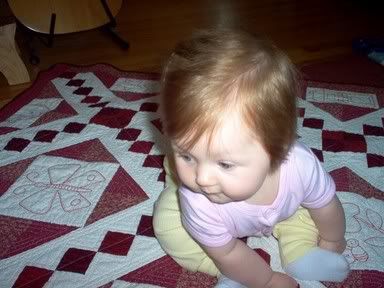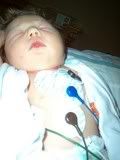After all the requisite measuring and weighing, our pediatrician sat down with us to explain the Holter report, which she had just gotten herself. She was great, explaining and answering questions, showing us the readout (which was not at all self-explanatory) and being generally gentle and understanding. The upshot was that the extra beats were in fact ventricular, not atrial, which was everyone’s assumption until now. Ventricular ectopic beats are more dangerous. Beanie was having runs of these extra ventricular beats, and not at all at a regular pace anymore. Our pediatrician thought we should see a cardiologist right away. She had the nurse make an appointment for us while we were there in her office. The cardiologist she wanted (or rather, his partner) spends one day a month in a city about 15 minutes from us; normally her office hours are an hour away. Fortunately for us, that one day for the month of February was the very next day. Our pediatrician told us, before we left, what the likely outcome would be, so we could prepare ourselves. Beanie would need medication, and the cardiologist would likely send us to the large teaching hospital an hour away so that she could start the medication while on monitors.
That night, we were left with lots of “what ifs” floating around in our heads. We all were telling each other, “It’s going to be okay,” but everyone was also walking around sad and introspective. Jay was rocking Beanie to sleep that night, singing Tom Waits to her (a habit he had already well established.) He had chosen “Fish and Bird” that night; he favors the songs from “Alice.” When he got to the last verse, however, he got choked up:
And tell me that you will wait for me
Hold me in your arms
I promise we never will part
I'll never sail back to the time
But I'll always pretend that you're mine
I know that we both must part
You can live in my heart
He couldn’t get the word “heart” out.
The next day we packed up and went out to the cardiologist. It was odd; Beanie was only 6 days old, and already she had been all over the western half of the state. She was so, so small compared to the other children and babies at the pediatrician’s office where the cardiologist was seeing patients. She was weighed and measured again, and her oxygen level was also taken. The cardiologist herself came in to see us. She was comfortable, matter-of-fact. She had the exact position that our pediatrician had predicted. The Holter reading was concerning; she wanted some more tests done, and she would call ahead to the PedICU at Baystate to see if they had a bed.
We ended up spending almost 3 hours at the cardiologist’s borrowed office. I nursed Beanie twice in that time. She was still a hungry, demanding newborn. She didn’t know what kinds of decisions were being made about her heart. Now that she was out of my body, they could do an ultrasound of her heart with more clarity. They also did another EKG, at which point Beanie was reaching the limit of her tolerance. I couldn’t hold her in my arms. I put my hands on her and tried to soothe her.
I should say that my mother was very impressed with both our pediatrician and the cardiologist, and that’s saying a lot. My mother is very critical of many doctors, including my grandparents’, and is not afraid to say so. Her faith in them calmed me considerably.
We went home to get some lunch and pack for Baystate. They were expecting us in the late afternoon, and it was an hour’s drive. I didn’t know what to pack; what would we need? The nursing pillow was key; I brought some clothes for Beanie (though she never ended up wearing anything but a t-shirt, hat and sometimes, socks), clothes for us, snacks, and books to read. The Nursing Mother’s Companion for me. I was still shaky in the nursing routine, and wanted to be armed for all contingencies. Mom was coming to the hospital with us, but then turning around to come back to our home. She would be looking after our house and the pets.
We knew how to get to the hospital now, though it wasn’t the Wesson Women’s entrance this time. We went straight up to the fourth floor, which was all children’s hospital. The PedICU had one of those big doors and a phone on the wall, the kind you have to pick up to ask someone to let you in. We went in and they pointed us toward the last room, technically the Intermediate Care Unit, not the Intensive Care Unit. They had a crib waiting for her. I didn’t know what to do with our stuff, or her. She was still in her car seat/infant carrier. There were two other cribs and one bed in the room, and not a lot of space around her crib. There were other parents there, and rocking chairs, and other chairs that looked like giant pink pleather lounge chairs.
A nurse came in, showed us that we could stow our stuff under the crib, and helped us get Beanie settled. She had the head of the crib raised, and made an upside-down U with receiving blankets to hold Beanie in a little nest. They started hooking her up to the monitors: heart, oxygen, blood pressure. We told them the story up until that point, and that we were expecting our cardiologist to meet us there. Once she got there, we would be starting the medicine—propranolol—which was the whole reason for us being there.
Propranolol is a beta blocker. Beanie’s irregular beats appear to be caused by an extra electrical focus. When her heart rate got high for whatever reason (crying, eating, snuggling…) the extra beats would kick in. The Propranolol’s job is to slow down her overall heart rate, so that the extra beats never kick in.
I’m sure we killed time somehow while we waited for the cardiologist. I nursed Beanie, we changed her. A baby across the room had a spinal tap, and we closed the curtains so as not to witness it. His own parents left the room. The other crib held a four-month old; I didn’t know what was wrong with him. He babbled and chattered to himself and no one. His parents left soon after we got there, leaving him with the TV arranged in his line of sight. We chatted with our neighbor on the other side of the curtain, and learned she and her son were not only from our area, but she and her husband both worked at my alma mater, and not only that, but the resident doctor who had taken our story when we first came in was also a grad, and of my class. I knew she looked familiar! Small world.
The cardiologist stopped by. The med wouldn’t be started until an IV was in. The IV took forever. Beanie’s tiny little newborn veins just weren’t prepared for it. When we saw them preparing the IV, Jay just started pacing and tearing up. I jumped in the fray and stroked her head with one hand while letting her suck on the pointer finger on the other hand. It took four tries and three or four different nurses before the IV was finally in. Beanie just sucked vigorously and grunted. No crying.
The first dose of propranolol was given at 8 pm. From then until June, our days would be divided by six hour segments. 2 o’clocks and 8 o’clocks were medicine time. Once she was asleep again we finally left her side to go get some dinner. There were two choices: the hospital cafeteria or the Friendly’s at the entrance.
We opted for the familiar. In our tired, stressed, anxious state it seemed the better option. It was like a fast(er)-food version of the family restaurant. Minimal choices, and order at the counter. I ordered a chicken wrap, and Jay ordered a Buffalo chicken sandwich. We sat down and started making cell phone calls. You can’t use cell phones in an ICU.
Unfortunately, though Jay has had the Buffalo chicken sandwich before, it was served here with blue cheese dressing, standard. When we got our food, and he saw the dressing, he was frustrated (he won’t eat anything white and creamy), but unwilling to make a big deal about it. He was too tired, too punchy. I, however, was not about to let him go without any food. I took the sandwich back to the counter and told them we wanted it without the dressing.
Now, you would expect that a Friendly’s within a hospital, much less the children’s entrance, would be a little…how shall I say it? Kind? Understanding? Not possessing of major bad attitude? Friendly? The woman (girl) at the counter gave me a look like “What’s your problem lady?” My problem? How about my 6-day-old baby hooked up to monitors and an IV upstairs. “Buffalo chicken is always served with bleu cheese,” she snarled. “Not necessarily,” I retorted, and walked away, fuming.
The stress of the entire day and that confrontation had my own heart pumping hard as I returned to my husband, who was still on his cell phone, updating family on the status of our baby girl. We finished our food quickly after his new sandwich arrived, and got out of there.
It turned out that only one of us could sleep by her side, and as the milk-bearer, that had to be me. Jay went down the hall to the “family lounge,” where people proceeded to wake him up by talking loudly in the middle of the night. I hunkered down on one of the pink lounge chairs and slept pretty well, considering. Beanie woke about every two hours to eat. She may have had a good 4-hour stretch at one point. Typical newborn schedule. The nurses gave her her 2 am med.
We could see the next day that the medicine was already working. From an average of 140-150 bpm (beats per minute), and occasional leaps up to 200+ bpm; it went down to an average of 100-120 bpm. Before we left, however, Beanie would have to have another Holter monitor to be sure that the medicine was working.
Breakfast that day, as well as the rest of our meals at Baystate were in the cafeteria. It actually wasn’t all that bad, for a cafeteria. The only time we left her side was to eat, and that was when we made phone calls as well. At one point, when we returned, a woman was sitting in the lounge where Jay had slept the night before, talking on her cell phone, despite the signs posted everywhere. That same righteous indignation that had risen in Friendly’s the night before crested in me again. “You can’t use a cell phone in here,” I told her, and pointed to the sign. I’ve got a baby in there, I thought to myself. How can you disregard the rules like this in a pediatric ICU? I told the nurses at the station after I passed through the doors, but they didn’t seem to think anyone would be able to stop her.
Beanie got her Holter around 1 pm. More wires coming out of my baby, but that wouldn’t stop me from holding her, rocking her, nursing her. The staff was very respectful of our nursing, and would come back later if they wanted vitals or to pick up soiled diapers (they had to count them). I tried to remember to take good care of myself as well. I was a week postpartum, and all this excitement had me bleeding heavily again. I kept refilling my water at the nurses’ station, and one of them found me some Tylenol out of her own personal stash. Mostly I had to keep off my feet, reading or watching the little TV on its suspended arm.
The rest of the day was comparatively quiet. Other children had come and gone in the Intermediate Care Room, and we had come to the realization that Beanie was in better shape than some. Her medicine was working. Other children were there for clearly the second, third, or fourth times. A little girl with a seizure disorder. Another with Crohn’s disease. We were lucky. Beanie would likely grow out of this arrhythmia after a year or so. Some children aren’t so lucky.
The nurses showed us how to give Beanie her medicine with a small syringe. The resident gave us a prescription for more to take home with us. The first pharmacist within the hospital didn’t carry Propranolol, and didn’t accept my insurance. The second one told me it would be several hours, but gave me a card with a number to call to check if it was ready when the Holter’s 24 hours was up. We really didn’t want to stay there any longer than was necessary.
In the end, everything went smoothly, and at the end of the 24 hours for the Holter, they let us go home. Beanie has had an appointment with the cardiologist every month when she comes to town, and she’s had two more Holters. The last one, in May, showed no more runs at all. The plan is to keep her on the med, increasing the dose every month as she gains weight (and boy, does she!) until she’s about 9 or 10 months old. Then keep the med at the same dose while she grows out of it. By the time she’s a year to 18 months, she will have grown out of it and they’ll do another Holter to see what her heart is up to. Hopefully, only about 120 beats per minute.






